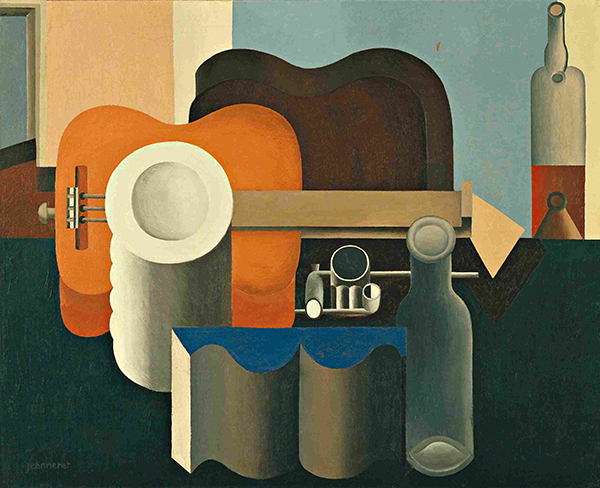Swiss National Day Bundesfeier: Le Corbusier
The first of August (Erschten Ougschte in Bernese) is the Swiss “Independence Day,” celebrating the establishment of the first Swiss Confederation of thirteen cantons (districts) seeking liberation from Austrian domination in 1291. My dear departed mother was Swiss and her family was from Bern, so I always try to recognize the day in some manner, especially since I only have one Swiss friend where I live.
 |
| Le Corbusier (1887–1965, Switzerland), Still Life, 1920. Oil on canvas, 31 7/8" x 39 3/8" (81 x 100 cm). Courtesy of the Museum of Modern Art, New York. © 2022 Artists Rights Society (ARS), New York. (MOMA-P0201lcars) |
You may have heard of architect, urban planner, designer, and, yes, painter, Le Corbusier. Because he worked mostly in France, it is often assumed that he is French. No, no, we Swiss claim him. He was instrumental in defining the “revision” of the Cubist style called Purism.
In 1917, Le Corbusier moved to Paris. While working on concrete structures under government contracts, he turned with great enthusiasm to painting. He met Cubist painter Amedée Ozenfant (1886–1966). Ozenfant was the pioneer of the Cubist offshoot style Purism, which rejected the complicated, fractured geometric forms of Cubism and returned painting to the pure, geometric forms of everyday objects.
Purism was a perfect fit for Le Corbusier, whose architectural aesthetic was one of simplified geometric forms stripped of all superfluous ornament. It was the beginning of Le Corbusier's life-long love of, but frustration with, painting.
Le Corbusier and Ozenfant put forth their views of the errors of Cubism in the book After Cubism (1918). It was an anti-Cubism diatribe that accused Cubism of becoming overly ornate and decorative. They deemed it irrational and romantic.
The machine was the inspiration for Purist paintings, wherein they sought architectural structure, purified (unadorned) forms, and the elimination of narrative or fantasy subjects. It differed from Futurism’s fascination with the machine because the style was limited almost entirely to still life, rather than glorifying industrial society, war, and motion. It is easy to see the curvilinear walls of some of Le Corbusier's later architecture in the rounded forms of Still Life.
The new architecture that evolved during the first three decades of the 1900s was characterized by the influence of the efficiency and streamlining of the machine. As an aesthetic, it was similar to what was also happening in painting, particularly in the movements of Cubism and Futurism.
Early modernist architects insisted that modern design was not only a reflection of society, but also a stimulus for improving social attitudes and behavior. This ideal was reflected in many early pioneering architectural movements such as Art Nouveau, De Stijl, the Arts and Crafts Movement, and the Bauhaus. The search for the perfect relationship between humans and architecture was engendered in forward-looking apartment buildings, public housing, school buildings, factories, and private housing.
Le Corbusier, pseudonym for Swiss-born Charles-Édouard Jeanneret, was an architectural pioneer of this period who spent his life searching for a reconciliation of human beings with nature and the modern machine. He initially trained as a watchmaker, his father's profession. While studying at the School of Fine Arts in Chaux-de-Fonds from age 13, he became convinced that architecture should be his career. He practiced this vocation on local projects between 1900 and 1905.
Between 1907 and 1911, Le Corbusier traveled throughout Europe and the Mediterranean, gleaning influences from a variety of architectural styles, including ancient Greek temples, Late Renaissance Italian villas, and popular seaside architecture on the Mediterranean. These experiences informed his interest in large collective spaces, geometric forms, and the use of landscape as background for his architectural designs. He worked briefly with ferro-concrete pioneer Auguste Perret (1874–1954) in Paris, and briefly with International Style pioneer Peter Behrens (1868–1940) in Berllin, where he undoubtedly associated with Walter Gropius (1883–1969) and Ludwig Mies van der Rohe (1886–1969).
Correlations to Davis programs: Explorations in Art 2e Grade 1: 1.5; Explorations in Art 2E Grade 2: 5.4; Explorations in Art 2E Grade 5: 2.1, 2.2; A Personal Journey 2E: 2.6; A Global Experience 2E: 5.2; Discovering Drawing 3E: Chapter 3; Exploring Visual Design 4E: p. 71; The Visual Experience 4E: 4.9

Comments